Investigation of Polystyrene-Based Microspheres from Different Copolymers and Their Structural Color Coatings on Wood Surface
Abstract
:1. Introduction
2. Materials and Methods
2.1. Materials and Substrates
2.2. Synthesis of Polystyrene Microspheres
2.3. Preparation of Structural Color Coatings on a Wood Surface Using PSt-Based Microspheres
2.4. Characterization
3. Results and Discussion
3.1. Effect of Copolymers on Properties of PSt-Based Microspheres
3.1.1. XPS Spectroscopic Analysis of Microspheres of PSt with Different Copolymers
3.1.2. FTIR Spectroscopic Analysis of Microspheres of Different PSt Copolymers
3.1.3. TEM Analysis of Microspheres of Different PSt Copolymers
3.2. Effect of Copolymer Composition on Properties of Coatings on a Wood Surface
3.2.1. SEM of Coatings on a Wood Surface
3.2.2. Reflectance Spectroscopy of Coatings on a Wood Surface
3.2.3. Structural Colors of Coatings on a Wood Surface
4. Conclusions
Author Contributions
Funding
Data Availability Statement
Acknowledgments
Conflicts of Interest
References
- Xiong, X.; Ma, Q.; Yuan, Y.; Wu, Z.; Zhang, M. Current situation and key manufacturing considerations of green furniture in China: A review. J. Clean Prod. 2020, 267, 121957. [Google Scholar] [CrossRef]
- Yang, L.; Liu, H. Effect of a combination of moderate-temperature heat treatment and subsequent wax impregnation on wood hygroscopicity, dimensional stability, and mechanical properties. Forests 2020, 11, 920. [Google Scholar] [CrossRef]
- Bekhta, P.; Niemz, P. Effect of high temperature on the change in color, dimensional stability and mechanical properties of spruce wood. Holzforschung 2003, 57, 539–546. [Google Scholar] [CrossRef]
- Hansmann, C.; Deka, M.; Wimmer, R.; Gindl, W. Artificial weathering of wood surfaces modified by melamine formaldehyde resins. Eur. J. Wood Wood Prod. 2006, 64, 198–203. [Google Scholar] [CrossRef]
- Liu, Y.; Shao, L.; Gao, J.; Guo, H.; Chen, Y.; Chen, Q.; Via, B.K. Surface photo-discoloration and degradation of dyed wood veneer exposed to different wavelengths of artificial light. Appl. Surf. Sci. 2015, 331, 353–361. [Google Scholar] [CrossRef]
- Robinson, S.C.; Hinsch, E.; Weber, G.; Leipus, K.; Cerney, D. Wood colorization through pressure treating: The potential of extracted colorants from spalting fungi as a replacement for woodworkers’ aniline dyes. Materials 2014, 7, 5427–5437. [Google Scholar] [CrossRef] [PubMed] [Green Version]
- Gutierrez, S.M.V.; Robinson, S.C. Microscopic analysis of pigments extracted from spalting fungi. J. Fungi 2017, 3, 15. [Google Scholar] [CrossRef] [PubMed] [Green Version]
- Hinsch, E.M.; Robinson, S.C. Comparing colorfastness to light of wood-staining fungal pigments and commercial dyes: An alternative light test method for color fastness. Coatings 2018, 8, 189. [Google Scholar] [CrossRef] [Green Version]
- Huang, X.; Kocaefe, D.; Kocaefe, Y.; Boluk, Y.; Pichette, A. A spectrocolorimetric and chemical study on color modification of heat-treated wood during artificial weathering. Appl. Surf. Sci. 2012, 258, 5360–5369. [Google Scholar] [CrossRef]
- Wang, X.; Tang, R.; Zhang, Y.; Yu, Z.; Qi, C. Preparation of a novel chitosan-based biopolymer dye and application in wood dyeing. Polymers 2016, 8, 338. [Google Scholar] [CrossRef]
- Zi, J.; Yu, X.; Li, Y.; Hu, X.; Xu, C.; Wang, X.; Liu, X.; Fu, R. Coloration strategies in peacock feathers. Proc. Natl. Acad. Sci. USA 2003, 100, 12576–12578. [Google Scholar] [CrossRef] [PubMed] [Green Version]
- Kolle, M.; Lethbridge, A.; Kreysing, M.; Baumberg, J.J.; Aizenberg, J.; Vukusic, P. Bio-inspired band-gap tunable elastic optical multilayer fibers. Adv. Mater. 2013, 25, 2239–2245. [Google Scholar] [CrossRef] [Green Version]
- Parker, A.R. Colour in Burgess Shale animals and the effect of light on evolution in the Cambrian. Proc. R. Soc. B Biol. Sci. 1998, 265, 967–972. [Google Scholar] [CrossRef] [Green Version]
- Pusey, P.N.; Van Megen, W.; Bartlett, P.; Ackerson, B.J.; Rarity, J.G.; Underwood, S.M. Structure of crystals of hard colloidal spheres. Phys. Rev. Lett. 1989, 63, 2753–2756. [Google Scholar] [CrossRef] [PubMed]
- Saranathan, V.; Osuji, C.; Mochrie, S.; Noh, H.; Narayanan, S. Crystals in butterfly wing scales. Proc. Natl. Acad. Sci. USA 2010, 107, 11676–11681. [Google Scholar] [CrossRef] [PubMed] [Green Version]
- Wang, J.; Wen, Y.; Ge, H.; Sun, Z.; Zheng, Y.; Song, Y.; Jiang, L. Simple fabrication of full color colloidal crystal films with tough mechanical strength. Macromol. Chem. Phys. 2006, 207, 596–604. [Google Scholar] [CrossRef]
- Aguirre, C.I.; Reguera, E.; Stein, A. Colloidal photonic crystal pigments with low angle dependence. ACS Appl. Mater. Inter. 2010, 2, 3257–3262. [Google Scholar] [CrossRef]
- Vigneron, J.P.; Simonis, P. Natural photonic crystals. Physica B 2012, 407, 4032–4036. [Google Scholar] [CrossRef]
- Chen, J.; Xie, J.; Wu, Z.; Elbashiry, E.M.A.; Lu, Y. Review of beetle forewing structures and their biomimetic applications in China: (I) On the structural colors and the vertical and horizontal cross-sectional structures. Mat. Sci. Eng. C Mater. 2015, 55, 605–619. [Google Scholar] [CrossRef]
- Wong, S.; Kitaev, V.; Ozin, G.A. Colloidal crystal films: Advances in universality and perfection. J. Am. Chem. Soc. 2003, 125, 15589–15598. [Google Scholar] [CrossRef]
- Cheng, B.; Ni, P.; Jin, C.; Li, Z.; Zhang, D.; Dong, P.; Guo, X. More direct evidence of the fcc arrangement for artificial opal. Opt. Commun. 1999, 170, 41–46. [Google Scholar] [CrossRef]
- Stöber, W.; Fink, A.; Bohn, E. Controlled growth of monodisperse silica spheres in the micron size range. J. Colloid. Interf. Sci. 1968, 26, 62–69. [Google Scholar] [CrossRef]
- Lei, X.; Yu, B.; Cong, H.; Tian, C.; Wang, Y.; Wang, Q.; Liu, C. Synthesis of monodisperse silica microspheres by a modified Stöber method. Integr. Ferroelectr. 2014, 154, 142–146. [Google Scholar] [CrossRef]
- You, B.; Wen, N.; Shi, L.; Wu, L.; Zi, J. Facile fabrication of a three-dimensional colloidal crystal film with large-area and robust mechanical properties. J. Mater. Chem. 2009, 19, 3594–3597. [Google Scholar] [CrossRef]
- Zhang, S.; Chen, J.; Taha, M. Synthesis of monodisperse styrene/methyl methacrylate/acrylic acid latex using surfactant-free emulsion copolymerization in air. J. Appl. Polym. Sci. 2009, 114, 1598–1605. [Google Scholar] [CrossRef]
- Shen, Z.; Yang, Y.; Lu, F.; Bao, B.; You, B. Self-assembly of binary particles and application as structural colors. Polym. Chem. 2012, 3, 2495–2501. [Google Scholar] [CrossRef]
- Liu, G.; Zhou, L.; Zhang, G.; Li, Y.; Chai, L.; Fan, Q.; Shao, J. Fabrication of patterned photonic crystals with brilliant structural colors on fabric substrates using ink-jet printing technology. Mater. Design 2017, 114, 10–17. [Google Scholar] [CrossRef]
- Xu, L.; Li, H.; Jiang, X.; Wang, J.; Li, L.; Song, Y.; Jiang, L. Synthesis of amphiphilic mushroom cap-shaped colloidal particles towards fabrication of anisotropic colloidal crystals. Macromol. Rapid Comm. 2010, 31, 1422–1426. [Google Scholar] [CrossRef]
- Kang, K.; Kan, C.; Du, Y.; Liu, D. Synthesis and properties of soap-free poly(methyl methacrylate-ethyl acrylate-methacrylic acid) latex particles prepared by seeded emulsion polymerization. Eur. Polym. J. 2005, 41, 439–445. [Google Scholar] [CrossRef]
- Kim, S.H.; Son, W.K.; Kim, Y.J.; Kang, E.G.; Kim, D.W.; Park, C.W.; Kim, W.G.; Kim, H.J. Synthesis of polystyrene/poly(butylacrylate) core–shell latex and its surface morphology. J. Appl. Polym. Sci. 2003, 88, 595–601. [Google Scholar] [CrossRef]
- Hoshino, F.; Kawaguchi, H.; Ohtsuka, Y. N-substituted acrylamide-styrene copolymer lattices III. Morphology of latex particles. Polym. J. 1987, 19, 1157–1164. [Google Scholar] [CrossRef] [Green Version]
- Kim, S.; Seo, Y.G.; Cho, Y.; Shin, J.; Gil, S.C.; Lee, W.M. Optimization of emulsion polymerization for submicron-sized polymer colloids towards tunable synthetic opals. Bull. Korean. Chem. Soc. 2010, 31, 1891–1896. [Google Scholar] [CrossRef] [Green Version]
- Zhao, T.; Zhang, Y.; Wang, J.; Song, Y.; Jiang, L. Fabrication of phase-change polymer colloidal photonic crystals. J. Nanomater. 2014, 4, 702089. [Google Scholar] [CrossRef]
- Sun, C.; Yao, Y.; Gu, Z. Fabrication of elastic colloidal crystal films from pure soft spheres. Colloid. Surface. A 2012, 402, 102–107. [Google Scholar] [CrossRef]
- Wang, J.; Wen, Y.; Feng, X.; Song, Y.; Jiang, L. Control over the wettability of colloidal crystal films by assembly temperature. Macromol. Rapid. Comm. 2006, 27, 188–192. [Google Scholar] [CrossRef]
- Liu, G.; Shao, J.; Zhang, Y.; Wu, Y.; Wang, C.; Fan, Q.; Zhou, L. Self-assembly behavior of polystyrene/methacrylic acid (P(St-MAA)) colloidal microspheres on polyester fabrics by gravitational sedimentation. J. Text. Inst. 2015, 106, 1293–1305. [Google Scholar] [CrossRef]
- Wang, P.H.; Pan, C.Y. Emulsion copolymerization of styrene with acrylic or methacrylic acids-distribution of the carboxylic group. Colloid Polym. Sci. 2001, 279, 98–103. [Google Scholar] [CrossRef]
- Zhang, Y.; Hao, X.; Zhou, J.; Zhang, Y.; Wang, J.; Song, Y.; Jiang, L. Tough and hydrophilic photonic crystals obtained from direct UV irradiation. Macromol. Rapid Comm. 2010, 31, 2115–2120. [Google Scholar] [CrossRef]
- Wang, J.; Wen, Y.; Hu, J.; Song, Y.; Jiang, L. Fine control of the wettability transition temperature of colloidal-crystal films: From superhydrophilic to superhydrophobic. Adv. Funct. Mater. 2007, 17, 219–225. [Google Scholar] [CrossRef]
- Huang, Y.; Zhou, J.; Su, B.; Shi, L.; Wang, J.; Chen, S.; Wang, L.; Zi, J.; Song, Y.; Jiang, L. Colloidal photonic crystals with narrow stopbands assembled from low-adhesive superhydrophobic substrates. J. Am. Chem. Soc. 2012, 134, 17053–17058. [Google Scholar] [CrossRef]
- Zhou, J.; Wang, J.; Huang, Y.; Liu, G.; Wang, L.; Chen, S.; Li, X.; Wang, D.; Song, Y.; Jiang, L. Large-area crack-free single-crystal photonic crystals via combined effects of polymerization-assisted assembly and flexible substrate. NPG Asia Mater. 2012, 4, e21. [Google Scholar] [CrossRef] [Green Version]
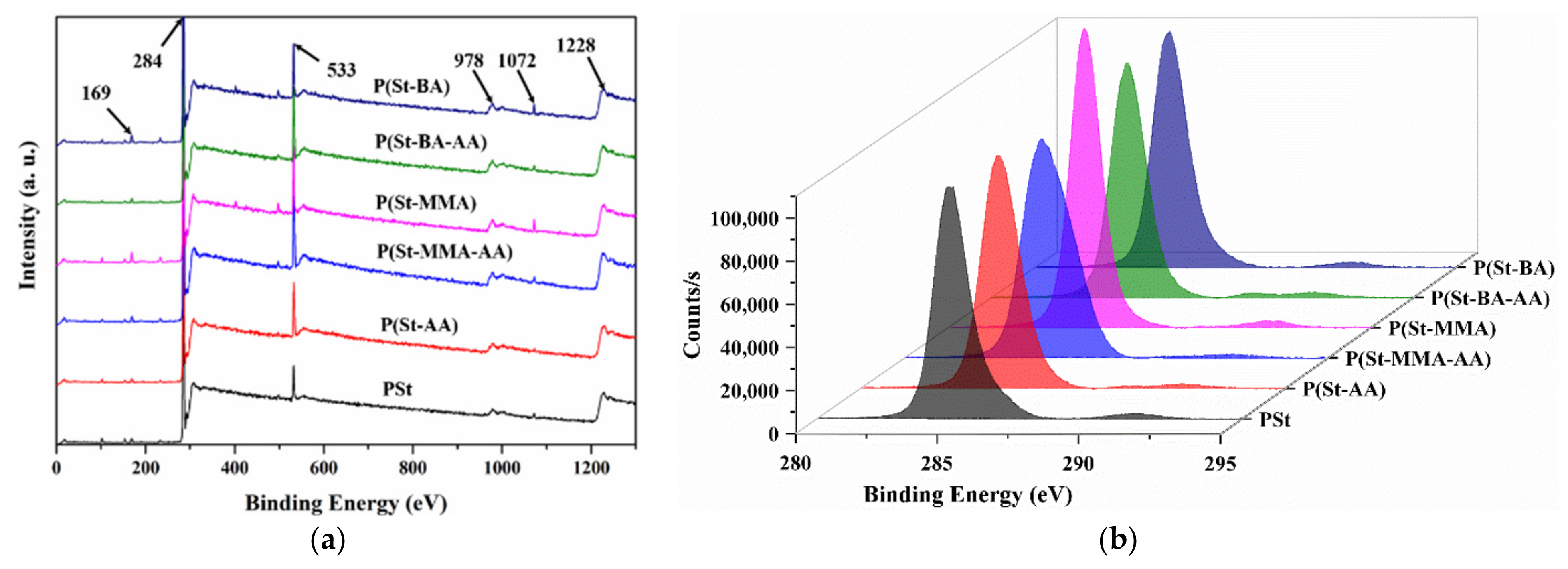

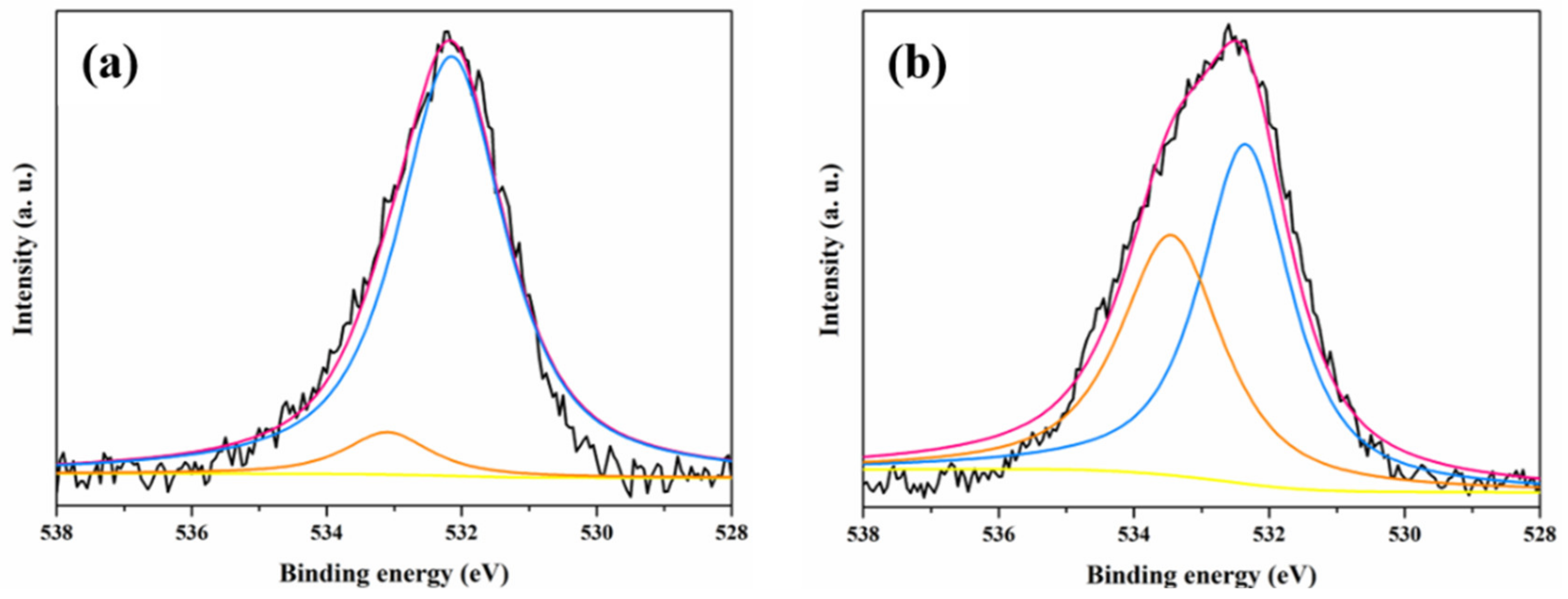

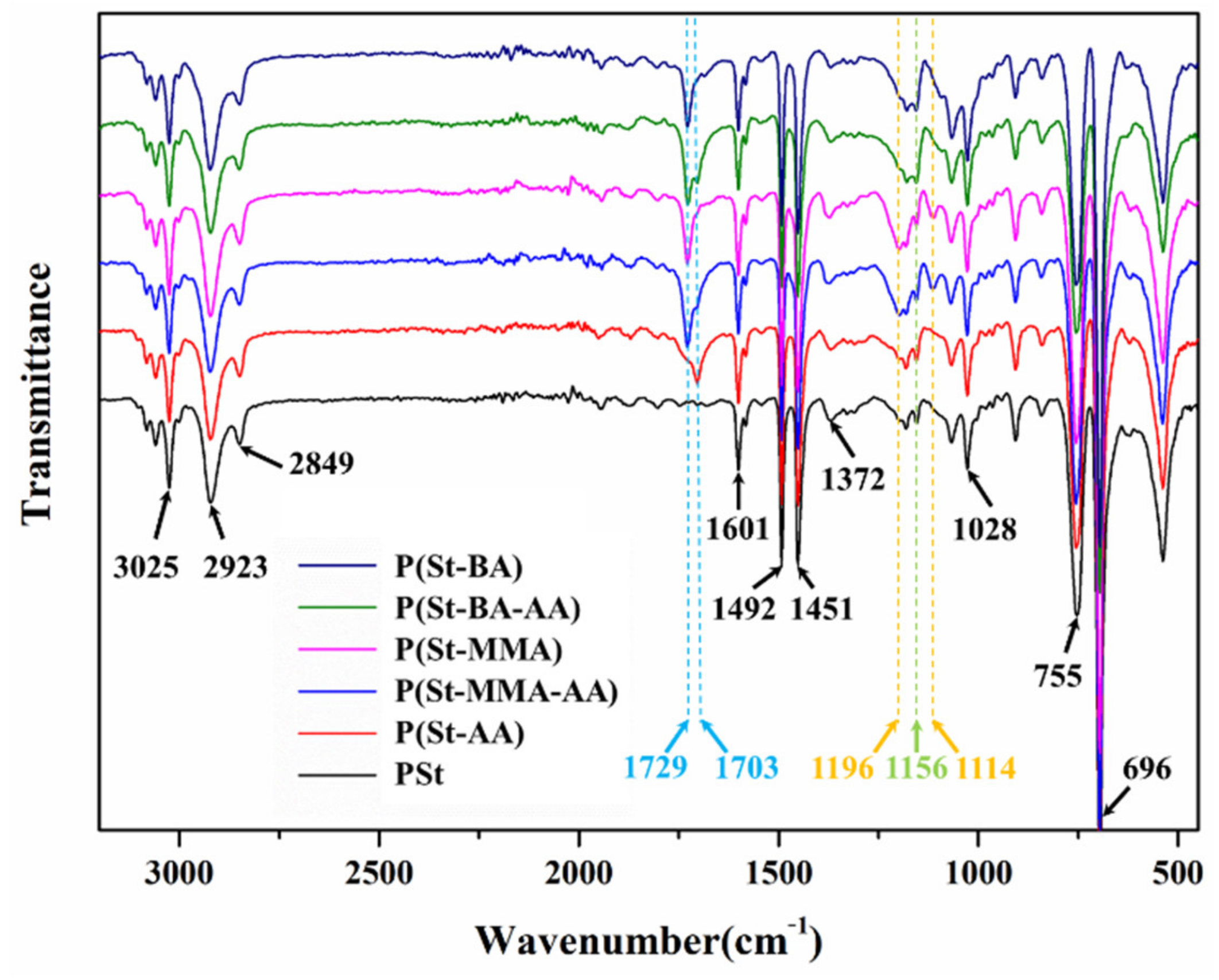

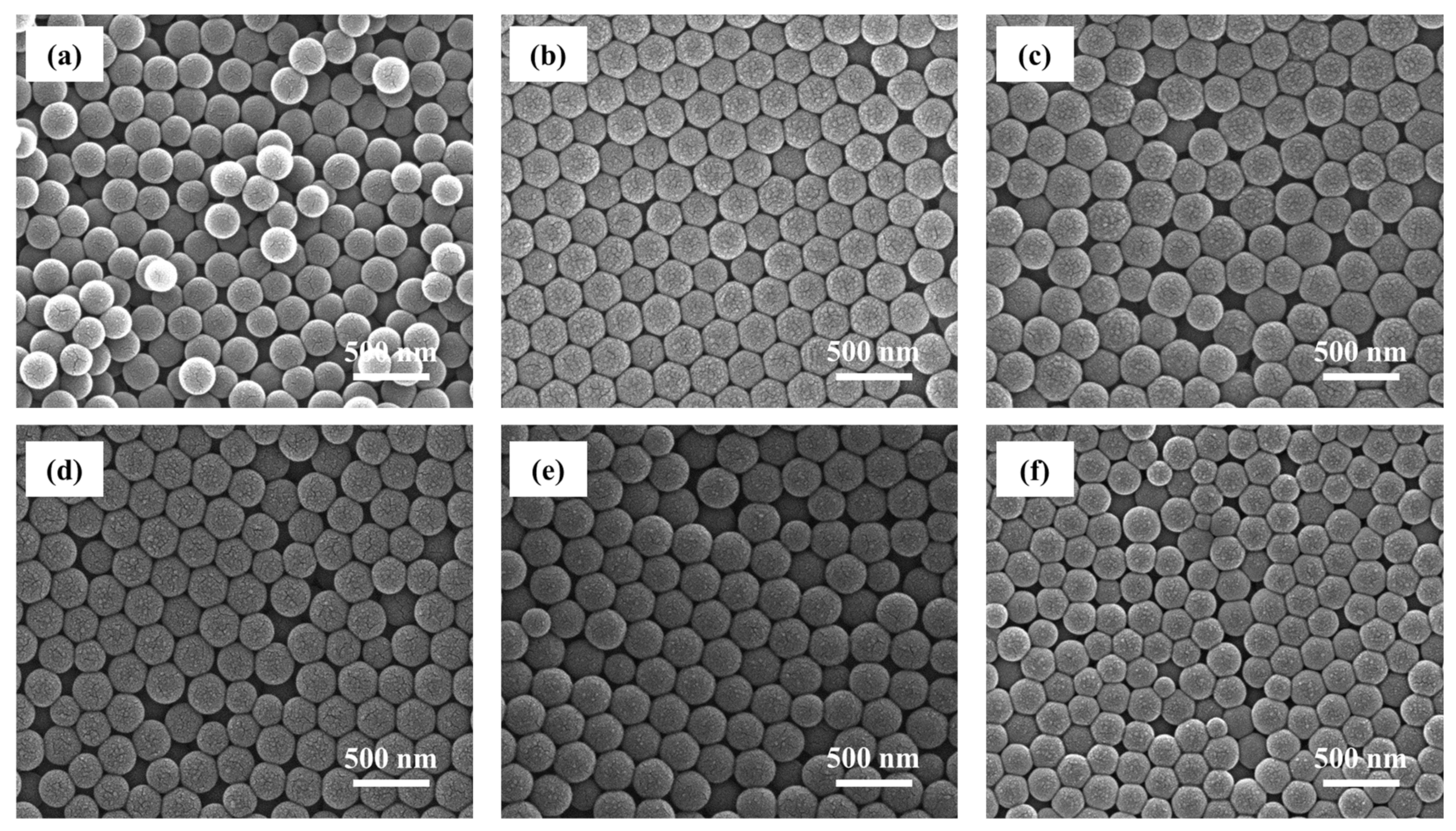


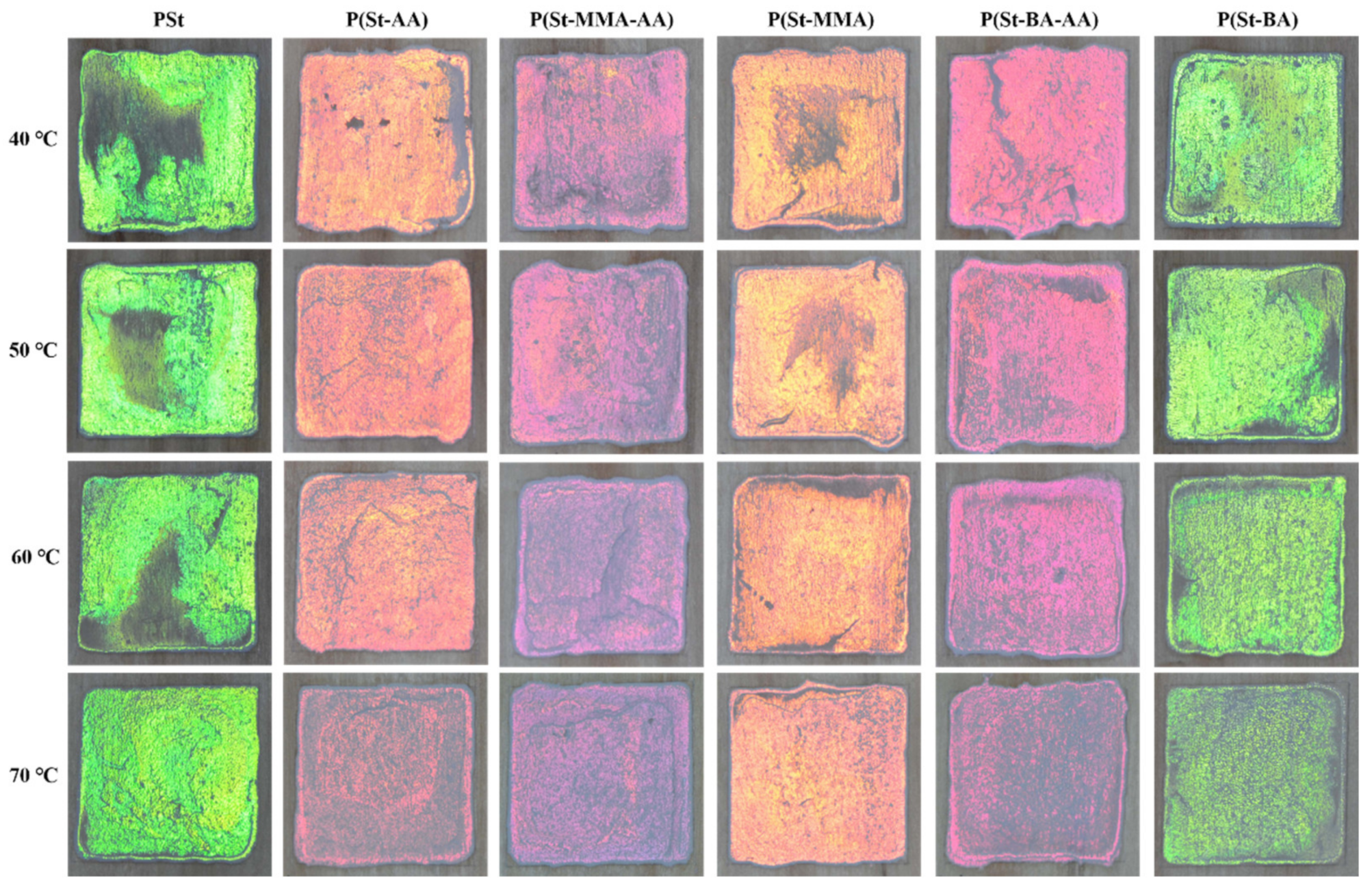
| Target Colloidal Microspheres | St (g) | AA (g) | MMA (g) | BA (g) | Deionized Water (mL) | Ethanol (mL) | SDBS (g) | APS (g) |
|---|---|---|---|---|---|---|---|---|
| PSt | 19 | – | – | – | 100 | 40 | 0.2 | 0.15 |
| P(St-AA) | 1 | – | – | |||||
| P(St-MMA-AA) | 1 | 1 | – | |||||
| P(St-MMA) | 1 | – | ||||||
| P(St-BA-AA) | 1 | – | 1 | |||||
| P(St-BA) | – | – | 1 |
Publisher’s Note: MDPI stays neutral with regard to jurisdictional claims in published maps and institutional affiliations. |
© 2020 by the authors. Licensee MDPI, Basel, Switzerland. This article is an open access article distributed under the terms and conditions of the Creative Commons Attribution (CC BY) license (http://creativecommons.org/licenses/by/4.0/).
Share and Cite
Liu, Y.; Hu, J. Investigation of Polystyrene-Based Microspheres from Different Copolymers and Their Structural Color Coatings on Wood Surface. Coatings 2021, 11, 14. https://doi.org/10.3390/coatings11010014
Liu Y, Hu J. Investigation of Polystyrene-Based Microspheres from Different Copolymers and Their Structural Color Coatings on Wood Surface. Coatings. 2021; 11(1):14. https://doi.org/10.3390/coatings11010014
Chicago/Turabian StyleLiu, Yi, and Jing Hu. 2021. "Investigation of Polystyrene-Based Microspheres from Different Copolymers and Their Structural Color Coatings on Wood Surface" Coatings 11, no. 1: 14. https://doi.org/10.3390/coatings11010014
APA StyleLiu, Y., & Hu, J. (2021). Investigation of Polystyrene-Based Microspheres from Different Copolymers and Their Structural Color Coatings on Wood Surface. Coatings, 11(1), 14. https://doi.org/10.3390/coatings11010014





